10 Styles of chiropractic adjusting tables
By Michael Dorausch, D.C.
When you’ve been in chiropractic practice long enough, you notice people doing the funniest things with chiropractic benches and tables. Having been around these pieces of equipment for nearly 2 decades, one begins to take for granted the assumption that everybody knows how to lie down on a table, how to use a table, and what the purpose of each table is for.
I grabbed photos of 10 different styles of chiropractic adjusting tables which I found in classified ads for chiropractic tables, and I’ll be displaying them here. A few will be marked with red arrows (and maybe some numbers) in an effort to provide some education for those seeking it. There’s no better way to see a chiropractic adjusting table then putting your face down in one, just make sure you’ve got a chiropractor handy to adjust you, or you may find yourself taking a nap and waking up with something we call “table face.”
The HiLo Adjusting Table
This is probably one of the most popular styles of chiropractic tables found in the traditional chiropractor’s office. I’m suspecting this one came out of somewhere on the East Coast since it’s rare to see that classic wood paneling in West Coast chiropractic offices.
The red arrow indicates where a person puts their face when getting adjusted. I’ll show another view of this table in the raised position.
The Exam Bench
The table viewed above is an old-school exam bench. There are chiropractic tables made similar to this that are much shorter in height. This is a bit taller than a typical straight adjusting table and the bottom steel shelves were likely used for holding face paper or other related office items. The red arrow indicates where a person would put their face when lying on the table.
Fishy Chiropractic Pediatric Table
You won’t find chiropractic tables like this in all offices, since some chiropractors don’t adjust children, and others adjust them on the same tables as they do adults. There are all sorts of pediatric tables and I think this one is particularly neat. The red arrow indicates where a child would put their face. What’s neat about this table is kids can walk up the back steps and lie face down (some kids in my office like to jump up onto the adult sized tables).
1960’s Adjusting Table
I’ll be honest, I’ve never seen a chiropractic adjusting table quite like this one. The red arrow indicates where someone would put their face. The white arrows shown in the photo above highlight two cranks, one on the into the table, and one on the bottom of the table. It looks like there are two heavy-duty springs near the base of the table. I suspect this table provided some sort of manual flexion or maybe the cranks were just used for increasing height and length.
Flexion Distraction Table
The table above is a flexion distraction chiropractic adjusting table. Who designs these chiropractic offices? Green carpeting in some kind of bland wall with a single gold framed picture is probably not going to win any office design competitions.
I’m not certain about the brand but I’m guessing this is a Titron or Phillips chiropractic flexion distraction table. The red arrow indicates where someone would put their face and the white arrow shows a series of dials that controls the motion of the bottom half of the table.
There’s a reason I keep marking headpieces with red arrows, I’ve watched far too many people put their butts on these when they’ve never been instructed how to properly lie down.
These babies are work horses and they’d been used by chiropractors for years in addressing complaints related to bulged and herniated discs, facet syndromes, and other low back complaints. Skilled chiropractors may use these tables for lumbar disc decompression. Most (like the one above) provide for someone’s legs to be strapped in.
Dual Drop Tables
Okay, these are just sweet. I’m envious of this chiropractic office. First of all it’s an open adjusting room and the glass and nature just beyond the glass are stimulating to the eye. Compare that to some of the backgrounds in photos above. Wow, I’d want to get adjusted here.
These are typically referred to as drop tables. These models appear to have full drops which means the head piece (red arrows) drops, the chest piece, and the pelvic pieces. I notice electrical cords so I assume these also elevate. There’s a package of face paper (marked with a blue arrow) which is typically a dead giveaway that this is a high-volume chiropractic office. In an office like this, patients will typically grab a sheet of face paper, and place it where the red arrows are, before lying down. A beautiful office and two beautiful tables.
Manual Flexion Adjusting Table
If you are a consumer, you have probably seen ads for spinal decompression and disc decompression services. Tables like this one have been used by chiropractors for a couple of decades in the approach to decompress vertebrae and take pressure off of discs and nerves, most commonly in the lumbar or low back region.
The red arrow shows where someone would put their face, and the white arrow shows a handlebar that is used by the practitioner. The handle is likely removable which allows the table to be used as a standard adjusting table when not being used for distraction.
Underneath the handlebar is a set of straps which hold someone’s legs in place when the practitioner is placing traction on the spine.
These are sometimes referred to as COX flexion distraction tables but I’m not sure if this is a actual Cox table. The difference between this table and the two shown above is that this one is specifically designed for addressing low back problems (disc herniations, disc bulges, spinal facet syndromes, lumbar stenosis) whereas the two drop tables shown above are more commonly used for day to day chiropractic adjusting.
Pony Drop Table
I want a pony! This is a neat little chiropractic adjusting table that’s probably one-of-a-kind. Looks like it was in storage somewhere and I think it’s super cool. The red arrow shows where someone would put their face when lying on the table. What’s neat about this table is it has a thoracic and pelvic drop. You can tell by the to black and silver handles sticking out between the table and the top of the ponys back. I bet this was custom-designed. I want one.
HiLo Table When Elevated
The above image shows a HiLo elevation chiropractic table in its upright position. These things can be super heavy (look at all the steel) and they can also be pricey. From what I’ve seen visiting chiropractic offices, this is the most popular chiropractic table in use. it has a cervical drop piece, thoracic drop pieces, and a pelvic drop. It looks like the thoracic section “breaks away” so that someone with a really big belly (like a pregnant mom) can comfortably lie facedown on the table.
The black arrow shows where a person could put their feet when lying face down. Sometimes people’s backs are in such bad shape that they can’t lie down on a traditional adjusting table. That’s probably what led to the creation of this style of table since someone can step onto the platform slowly be brought down to a horizontal position. This was the style of table used in the film Jacob’s Ladder.
Fabric Covered Bench
I am wrapping up this post with an image of a flat bench adjusting table. This one is covered in fabric which I think is becoming less and less popular. More tables today have a simulated leather covering or some style of vinyl covering. I’ve always thought it would be cool to have table covers made out of animal skins but they’d be terribly difficult to keep clean.
Tables like this are economical and sometimes include a drop piece in the cervical or neck area. it’s not uncommon to see this same style of table with metal legs, depending on who the manufacturer is.
You know what the red arrow indicates?


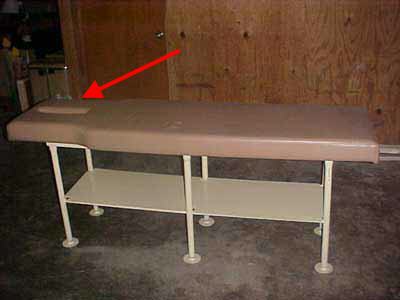
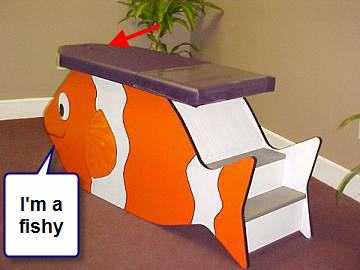
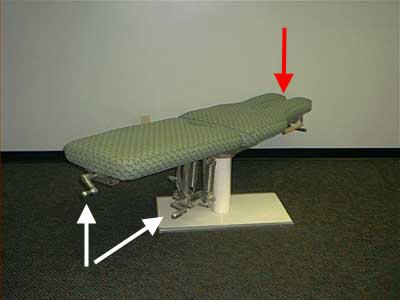

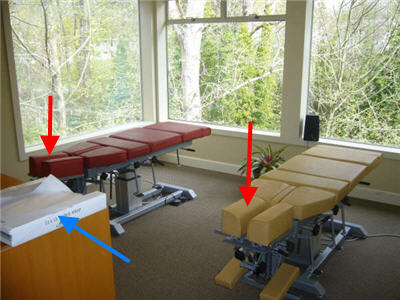
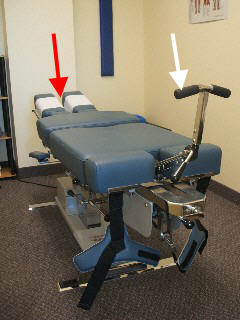
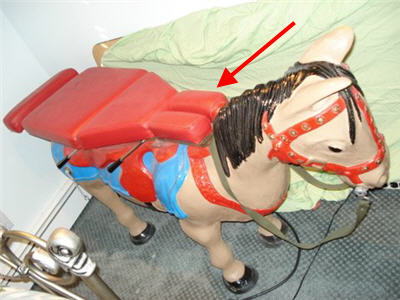
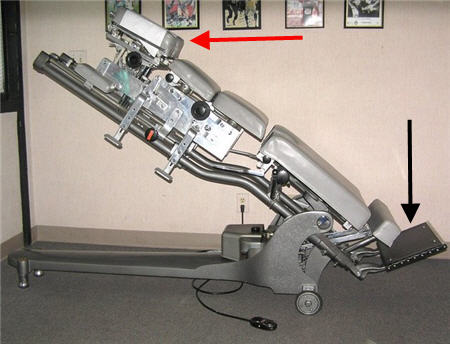
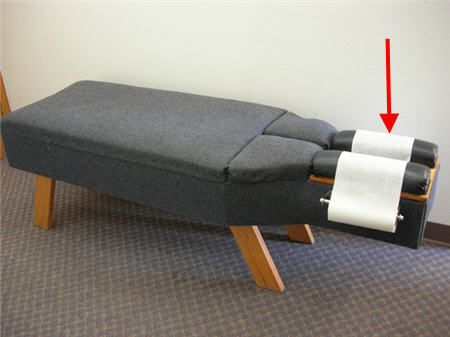

Hi Michael —
As a patient, I found this lineup of chiropractic tables Then and Now just fascinating. I wouldn’t mind having that little Fishy table for my grandkids, either. Because of my age, multiple joint implants, and a bunch of other stuff, I have been lying prone on the boring old exam table for my adjustments until TODAY! At last I was allowed onto what I’m pretty sure were like your picture of the drop tables: at least, the face part dropped, the part that hit me just under the bosom dropped, the pelvic part dropped, and the part supporting the legs went up and down. Oh yes, and I nearly forgot — the thoracic section also could be moved left or right of center. All I can say is — BE CAREFUL WHAT YOU WISH FOR, YOU MIGHT GET IT! It was an… interesting… experience.
I am so fortunate to have stumbled across Dr. David Klein of Seaside Chiropractic in La Jolla, CA! I am getting my “antique frame,” as my mother used to say when she was younger than I am, back for my own again through chiropractic, when orthopedic surgery just seemed to be putting more and more pieces of titanium into me, and then taking them out again some years later and replacing them when they went bad. I am a BIG chiropractic fan now.
Thanks for all your good articles. I enjoy what you have to say. Best wishes — Betsy Gordon